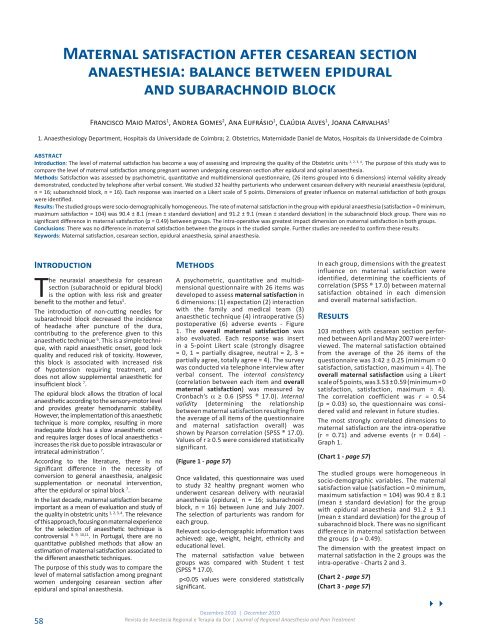Revista N. 62 - Clube de Anestesia Regional
Revista N. 62 - Clube de Anestesia Regional
Revista N. 62 - Clube de Anestesia Regional
Create successful ePaper yourself
Turn your PDF publications into a flip-book with our unique Google optimized e-Paper software.
58<br />
Maternal satisfaction after cesarean section<br />
anaesthesia: balance between epidural<br />
and subarachnoid block<br />
Introduction<br />
Francisco Maio Matos 1 , Andrea Gomes 2 , Ana Eufrásio 1 , Claúdia Alves 1 , Joana Carvalhas 1<br />
1. Anaesthesiology Department, Hospitais da Universida<strong>de</strong> <strong>de</strong> Coimbra; 2. Obstetrics, Maternida<strong>de</strong> Daniel <strong>de</strong> Matos, Hospitais da Universida<strong>de</strong> <strong>de</strong> Coimbra<br />
ABSTRACT<br />
Introduction: The level of maternal satisfaction has become a way of assessing and improving the quality of the Obstetric units 1, 2, 3, 4 . The purpose of this study was to<br />
compare the level of maternal satisfaction among pregnant women un<strong>de</strong>rgoing cesarean section after epidural and spinal anaesthesia.<br />
Methods: Satisfaction was assessed by psychometric, quantitative and multidimensional questionnaire, (26 items grouped into 6 dimensions) internal validity already<br />
<strong>de</strong>monstrated, conducted by telephone after verbal consent. We studied 32 healthy parturients who un<strong>de</strong>rwent cesarean <strong>de</strong>livery with neuraxial anaesthesia (epidural,<br />
n = 16; subarachnoid block, n = 16). Each response was inserted on a Likert scale of 5 points. Dimensions of greater influence on maternal satisfaction of both groups<br />
were i<strong>de</strong>ntified.<br />
Results: The studied groups were socio-<strong>de</strong>mographically homogeneous. The rate of maternal satisfaction in the group with epidural anaesthesia (satisfaction = 0 minimum,<br />
maximum satisfaction = 104) was 90.4 ± 8.1 (mean ± standard <strong>de</strong>viation) and 91.2 ± 9.1 (mean ± standard <strong>de</strong>viation) in the subarachnoid block group. There was no<br />
significant difference in maternal satisfaction (p = 0.49) between groups. The intra-operative was greatest impact dimension on maternal satisfaction in both groups.<br />
Conclusions: There was no difference in maternal satisfaction between the groups in the studied sample. Further studies are nee<strong>de</strong>d to confirm these results.<br />
Keywords: Maternal satisfaction, cesarean section, epidural anaesthesia, spinal anaesthesia.<br />
The neuraxial anaesthesia for cesarean<br />
section (subarachnoid or epidural block)<br />
is the option with less risk and greater<br />
benefit to the mother and fetus 5 .<br />
The introduction of non-cutting needles for<br />
subarachnoid block <strong>de</strong>creased the inci<strong>de</strong>nce<br />
of headache after puncture of the dura,<br />
contributing to the preference given to this<br />
anaesthetic technique 6 . This is a simple technique,<br />
with rapid anaesthetic onset, good lock<br />
quality and reduced risk of toxicity. However,<br />
this block is associated with increased risk<br />
of hypotension requiring treatment, and<br />
does not allow supplemental anaesthetic for<br />
insufficient block 7 .<br />
The epidural block allows the titration of local<br />
anaesthetic according to the sensory-motor level<br />
and provi<strong>de</strong>s greater hemodynamic stability.<br />
However, the implementation of this anaesthetic<br />
technique is more complex, resulting in more<br />
ina<strong>de</strong>quate block has a slow anaesthetic onset<br />
and requires larger doses of local anaesthetics -<br />
increases the risk due to possible intravascular or<br />
intratecal administration 7 .<br />
According to the literature, there is no<br />
significant difference in the necessity of<br />
conversion to general anaesthesia, analgesic<br />
supplementation or neonatal intervention,<br />
after the epidural or spinal block 7 .<br />
In the last <strong>de</strong>ca<strong>de</strong>, maternal satisfaction became<br />
important as a mean of evaluation and study of<br />
the quality in obstetric units 1, 2, 3, 4 . The relevance<br />
of this approach, focusing on maternal experience<br />
for the selection of anaesthetic technique is<br />
controversial 8, 9, 10,11 . In Portugal, there are no<br />
quantitative published methods that allow an<br />
estimation of maternal satisfaction associated to<br />
the different anaesthetic techniques.<br />
The purpose of this study was to compare the<br />
level of maternal satisfaction among pregnant<br />
women un<strong>de</strong>rgoing cesarean section after<br />
epidural and spinal anaesthesia.<br />
Methods<br />
A psychometric, quantitative and multidimensional<br />
questionnaire with 26 items was<br />
<strong>de</strong>veloped to assess maternal satisfaction in<br />
6 dimensions: (1) expectation (2) interaction<br />
with the family and medical team (3)<br />
anaesthetic technique (4) intraoperative (5)<br />
postoperative (6) adverse events - Figure<br />
1. The overall maternal satisfaction was<br />
also evaluated. Each response was insert<br />
in a 5-point Likert scale (strongly disagree<br />
= 0, 1 = partially disagree, neutral = 2, 3 =<br />
partially agree, totally agree = 4). The survey<br />
was conducted via telephone interview after<br />
verbal consent. The internal consistency<br />
(correlation between each item and overall<br />
maternal satisfaction) was measured by<br />
Cronbach’s a ≥ 0.6 (SPSS ® 17.0). Internal<br />
validity (<strong>de</strong>termining the relationship<br />
between maternal satisfaction resulting from<br />
the average of all items of the questionnaire<br />
and maternal satisfaction overall) was<br />
shown by Pearson correlation (SPSS ® 17.0).<br />
Values of r ≥ 0.5 were consi<strong>de</strong>red statistically<br />
significant.<br />
(Figure 1 - page 57)<br />
Once validated, this questionnaire was used<br />
to study 32 healthy pregnant women who<br />
un<strong>de</strong>rwent cesarean <strong>de</strong>livery with neuraxial<br />
anaesthesia (epidural, n = 16; subarachnoid<br />
block, n = 16) between June and July 2007.<br />
The selection of parturients was random for<br />
each group.<br />
Relevant socio-<strong>de</strong>mographic information t was<br />
achieved: age, weight, height, ethnicity and<br />
educational level.<br />
The maternal satisfaction value between<br />
groups was compared with Stu<strong>de</strong>nt t test<br />
(SPSS ® 17.0).<br />
p


